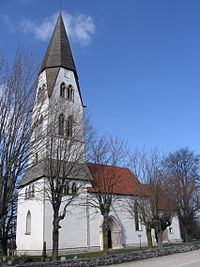There are 92 well-preserved churches from the Middle Ages on the Swedish island of Gotland, more than in any other part of Sweden and unusually many compared with other parts of Europe.[1][2][3] Benefiting from its location in the middle of the Baltic Sea, the island enjoyed an increase in wealth thanks to expanding trade between Western and Eastern Europe, giving the inhabitants the means to build large and prestigious churches. The preserved churches date from between the early 12th century and the middle of the 14th century.[4][5] The first churches were stave churches, but of these only fragments remain. The oldest substantially preserved churches on Gotland are simple Romanesque churches. Church architecture remained conservative on Gotland, and, while Gothic forms eventually replaced Romanesque, it never acquired the structurally light character it did elsewhere in Europe. The churches built during the first half of the 14th century on Gotland are sometimes referred to as "counter-Gothic" (kontragotik) in Swedish literature.
The churches were often decorated inside with paintings on walls and vaults and stained-glass windows, as well as decorative sculptures both inside and outside. In the Gothic period particularly, the portals of the churches were adorned with stone sculptures. Workshops specialising in the production of decorated baptismal fonts established themselves on Gotland during the 12th century and supplied the churches with fonts, which in many cases still exist in the churches. Wooden sculptures were also produced from an early time, including rood crosses and sculptures of saints like the Viklau Madonna.
In the middle of the 14th century, Gotland entered a period of decline and turmoil, and suffered a loss of trade from which the island would never recover. No new churches were built on the island after around 1350. In Visby, only Visby Cathedral was maintained, while other churches, of which there were at least twelve, were left to decay. The systematic study of the churches on Gotland began in the 19th century.
- ^ "Välkommen till Visby stift" [Welcome to the Diocese of Visby]. Diocese of Visby (in Swedish). Church of Sweden. Retrieved 2 July 2020.
- ^ Augustsson 1996, p. 70.
- ^ Andrén 2017, p. 152.
- ^ Andrén 2017, p. 153.
- ^ Lagerlöf & Svahnström 1991, pp. 19–34.


